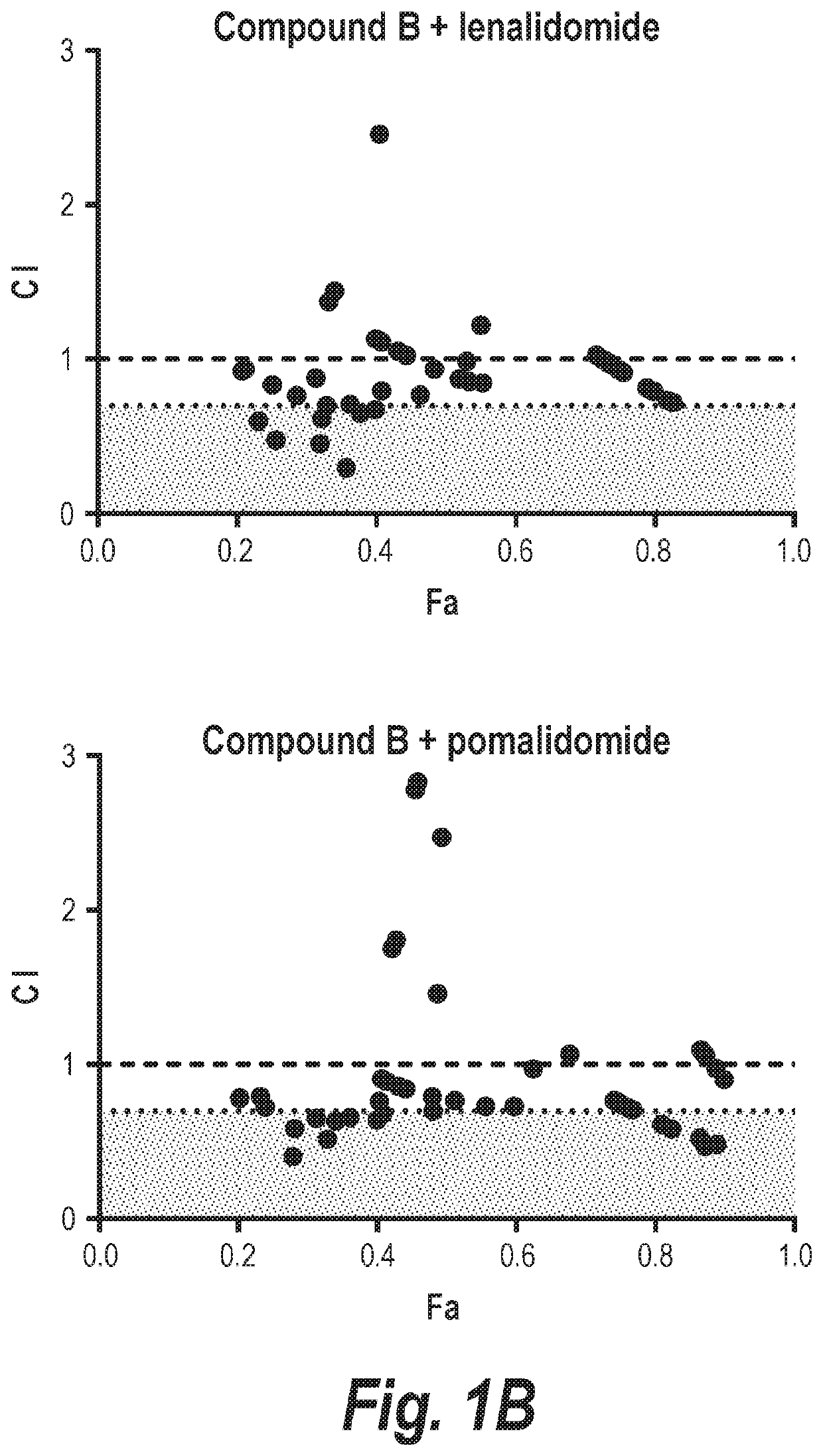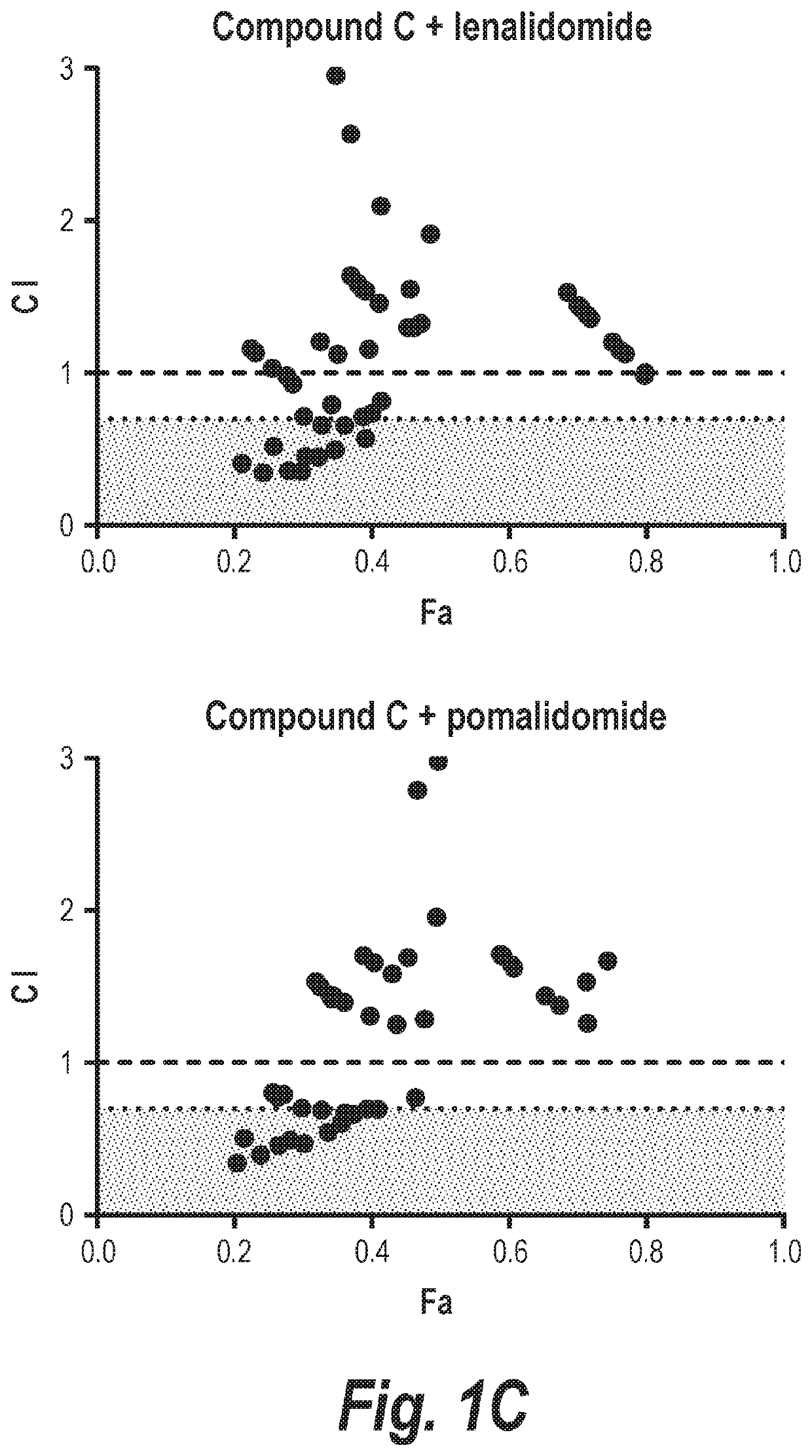Increasing expression of interferon regulated genes with combinations of histone deacetylase inhibitors and immunomodulatory drugs
a technology of histone deacetylase inhibitors and immunomodulatory drugs, which is applied in the direction of drug compositions, medical preparations, antineoplastic agents, etc., can solve the problems of synergistic increase in the expression and secretion of ccl4 protein in the cancer cells, and achieve the effect of increasing the expression of interferon-regulated genes, enhancing the recognition of cancer cells, and increasing the expression of genes
- Summary
- Abstract
- Description
- Claims
- Application Information
AI Technical Summary
Benefits of technology
Problems solved by technology
Method used
Image
Examples
example 1
HDAC6 Inhibitors Synergize with IMiDs in Multiple Myeloma Cell Killing
[0247]In this experiment, it is shown that combining an HDAC6-selective inhibitor (Compound A or Compound B) with either lenalidomide or pomalidomide leads to synergistic decreases in the viability of two different multiple myeloma cell lines in vitro (MM.1s and H929; FIGS. 1 and 2). The relevance of inhibition of HDAC6 to this synergistic effect was validated by demonstrating synergistic interactions of either IMiD molecule with Compound C, which is more than 300-fold selective for HDAC6 over class I HDACs. Additionally, staining of H929 cells for markers of apoptosis demonstrated that treatment with a combination of Compound A plus an IMiD led to an approximately 1.6-2 fold increase in cells entering apoptosis relative to cells treated with either agent alone. Further, the combination of Compound A, lenalidomide, and dexamethasone was well tolerated in vivo with no overt evidence of toxicity (FIG. 9A), and an in...
example 2
Combinations of HDAC6 Inhibitors and IMiDs Results in Synergistic Decreases in Myeloma Cell Growth and Viability
[0251]This example shows that the combination of HDAC6-selective inhibitors and IMiDs results in synergistic decreases in myeloma cell growth and viability.
[0252]H929 (FIGS. 5A & 5B) or MM.1s (FIGS. 5C & 5D) myeloma cells were exposed to increasing doses of the HDAC6-selective inhibitors Compound A (FIGS. 5A & 5C) or Compound C (FIGS. 5B & 5D) alone or in combination with lenalidomide (FIGS. 5A & 5C) or pomalidomide (FIGS. 5B & 5D). A constant ratio was maintained between the dose of the HDAC6i and IMiD, and cell viability was assessed at 72 hr by MTS assay. Calcusyn software was then used to determine the combination index (CI) value at each dose combination and the relative fraction affected (FA) (Actual), and a simulation was run to estimate the CI value across the entire FA range (Simulation). The measurement of CI values less than 1 in all combinations strongly suppor...
example 3
The Combination of an HDAC6 Inhibitor and IMiDs Affects Cellular Proliferation and Cell Cycle Progression
[0253]This example shows that treatment of multiple myeloma cells with Compound A and / or IMiDs results in decreased cell cycle progression.
[0254]H929 (FIGS. 6A & 6B) or MM.1s (FIGS. 6C & 6D) myeloma cells were exposed to drug for 3 (FIGS. 6A & 6C) and 5 (FIGS. 6B & 6D) days and cell cycle distribution was assessed by flow cytometry via incorporation of propidium iodide. The relative fraction of cells in each stage of the cell cycle (G0 / G1, S, and G2 / M) as well as the fraction of dead cells (Sub G1) was then estimated. The cells were treated with DMSO, Compound A (2 μM) lenalidomide (2 μM) pomalidomide (1 μM) or combinations of Compound A with either IMiD. Treatment with Compound A resulted in a small reduction of cells undergoing division in S phase, while treatment with either IMiD, alone or in combination with Compound A, led to a reduction in the percentage of cells in the S a...
PUM
| Property | Measurement | Unit |
|---|---|---|
| time | aaaaa | aaaaa |
| time | aaaaa | aaaaa |
| time | aaaaa | aaaaa |
Abstract
Description
Claims
Application Information
 Login to View More
Login to View More - R&D
- Intellectual Property
- Life Sciences
- Materials
- Tech Scout
- Unparalleled Data Quality
- Higher Quality Content
- 60% Fewer Hallucinations
Browse by: Latest US Patents, China's latest patents, Technical Efficacy Thesaurus, Application Domain, Technology Topic, Popular Technical Reports.
© 2025 PatSnap. All rights reserved.Legal|Privacy policy|Modern Slavery Act Transparency Statement|Sitemap|About US| Contact US: help@patsnap.com



